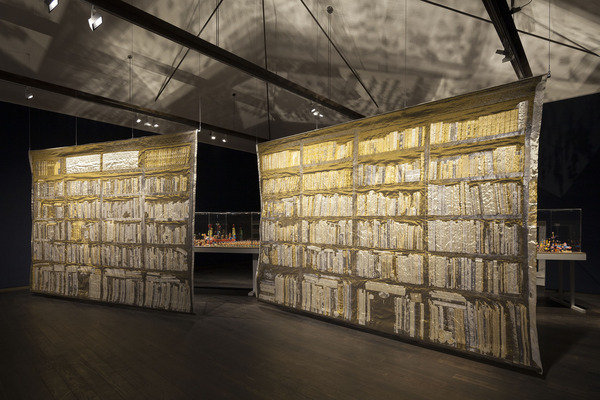Pae White
dal 7/10/2013 al 11/10/2014
Segnalato da
7/10/2013
Pae White
MAK Austrian Museum of Applied Arts / Contemporary Art, Wien
ORLLEGRO. An aggregation of fabrications, interpretations, simulations of history, narratives, and objects, some of which were sampled from works in the MAK collection. Playing with the idea of the epic and magical, White produced monumental tapestries woven entirely out of carefully-selected metallic thread.

curator Bärbel Vischer
Pae White’s solo exhibition ORLLEGRO is an aggregation of fabrications, interpretations, simulations of history, narratives, and objects, some of which were sampled from works in the MAK collection. The title ORLLEGRO, references a fictitious word invented by the textile industry in the 1950s, when textile production in
the US was at its most robust. This long forgotten, epic sounding word promised a
magical material that was a faux version of something real and perhaps altered the
way the world viewed synthetics: assigning an invented word to a fake material, it
activated a false nostalgia from an artificial past to render a stylish, more sophisticated—yet equally artificial—future.
Playing with the idea of the epic and magical, White produced monumental tapestries
woven not out of the colored cotton and polyester threads of her past weavings, but
entirely out of carefully-selected metallic thread. In these works, White questions the
expected, more conventional depiction of historic subject matter in large scale tapestries by substituting smaller-scale histories —broken links, digital debris, fabric
scraps, and entire sections of White’s own personal library—and monumentalizing
them through the perceived opulence of the metallic thread.
While working at the MAK in preparation for OTHERS (MAK Permanent Collection
Contemporary Art, 21 November–23 June 2013), White mined the museum collection for raw material, finding that the areas that most interested her were the sections
of storage inhabited by objects whose authors were mostly unknown. The absence of
clear authorship seems to have caused these objects to slip between the cracks of
typological classification, relegating them to curatorial oblivion. By repurposing some
of these forms White reshaped the meaning of the objects, freeing them from the
familiar and perhaps tired narrative, and rejecting received interpretations in favor of
those hoping to create a new viewership and stimulate a set of associations and
memories of those very objects for the audience.
During one of these visits through the MAK storage White encountered a trove of
long forgotten toys produced in Vienna in the 1920’s. She documented these thoroughly, studied them carefully, and arranged them into a multitude of configurations.
After a series of edits, a chess set was born, but one that disrupts the traditional hierarchy of the game by equalizing the pieces. Images of this set were then launched into
the world, specifically to a group of fabricators that she knew and worked with regularly in Mexico, Lithuania, and China and a few new ones in Germany and Ethiopia; a
small group of Los Angeles based artists also stepped in for the exercise as well as an
artist in the UK. The objective was to resuscitate these nameless, neglected objects by
inviting fresh and detailed scrutiny of them, eliciting an array of interpretations from
around the world as well as creating a cultural cross-pollination of form and color.
A 720-page artist’s book is also found in the exhibition. Acting as an unstructured
index for both O R L L E G R O and OTHERS, this book is a relentless repository of
rarely seen ephemera from the MAK’s collection as well as bits and pieces from
White’s personal collection of street ephemera. Included are scans of hundreds of
katagami (Japanese cut stencils), of numerous commercial paper (authors unknown),
and of leather stamp imprints from the Wiener Werkstätte, all from the MAK’s collection. Interspersed are scans of paper scraps found on the streets of East Los Angeles,
as well as source images for the tapestries, etc.
Pae White (*1963 in Pasadena, California, lives and works in Los Angeles) studied for
her MFA at Art Center College of Design, Pasadena, California, with professors including Jeremy Gilbert-Rolfe, Mike Kelley, and Stephen Prina. White has presented
her work in numerous international exhibitions, including: selected Solo Exhibitions;
Too much night, again, South London Gallery, London (2013); In Love with Tomorrow, Langen Foundation, Neuss, Germany (2013); S U M M E R X X, The Fabric
Workshop and Museum, Philadelphia (2012), Material Mutters, The Power Plant,
Toronto (2010) and Site Santa Fe (2011); and selected Group Exhibitions; Decorum:
Carpets and Tapestries by Artists, Musée d’Art Moderne de la Ville de Paris (2013);
Art & Textiles, Kunstmuseum Wolfsburg; the Whitney Biennial (2010); 53rd Venice
Biennale (2009); Skulptur Projekte Münster 07 (2007).
Image from left to right: OroLibro Sud, 2013; OroLibro Nord, 2013
Courtesy of the artist and neugerriemschneider, Berlin
© MAK/Katrin Wißkirchen
Press Office:
Judith Anna Schwarz-Jungmann (Head)
Sandra Hell-Ghignone
Veronika Träger
Lara Steinhäußer
T +43 1 71136-233, 229, 212 F +43 1 71136-227 presse@MAK.at
Opening Tuesday, 8 October 2013, 7 p.m.
MAK Permanent Collection Contemporary Art
MAK, Stubenring 5, 1010 Vienna
Opening Hours
Tue 10 a.m.–10 p.m., Wed–Sun 10 a.m.–6 p.m.
Free admission on Tuesdays from 6–10 p.m.
Admission
€ 7.90 / reduced € 5.50 / family ticket € 11
Free admission for children and teens up to 19



